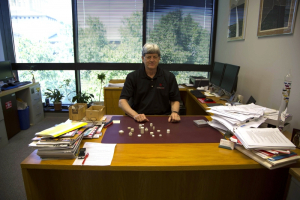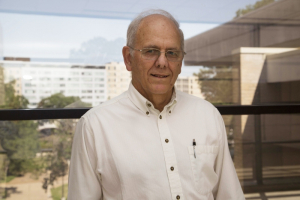Two faculty members from the University of Houston Cullen College of Engineering have won prestigious awards from the IEEE (Institute of Electrical and Electronics Engineers) Antennas and Propagation Society (APS). This marks the first time that one institution won two of these prestigious IEEE-APS awards in the same year.
Stuart Long, professor of electrical and computer engineering and associate dean for Undergraduate Research and the University of Houston’s Honors College, was awarded the John Kraus Antenna Award. Don Wilton, professor of electrical and computer engineering, was awarded the inaugural Harrington-Mittra Award in Computational Electromagnetics.
-------
Stuart Long – IEEE-APS John Kraus Antenna Award
Stuart Long was awarded the John Kraus Antenna Award from IEEE-APS. The Kraus Antenna Award is reserved for an individual or team that has made a significant advance in antenna technology. According to the IEEE-APS website, this includes inventing a new or substantially improved antenna device, a new concept for electromagnetic transmission, or an antenna design that yields a heretofore unknown capability. Long’s inventive antenna design fits all three criteria.
Long’s work with antennas at the University of Houston began in the 1970’s, when he helped to develop a new class of antennas – known as microstrip antennas – which are currently used in nearly all cell phones and wireless communications devices.
But the novel design which won Long the Kraus Antenna Award was for the dielectric resonator antenna. Long developed the first-ever dielectric resonator antenna in the 1980’s for use in military communications systems. Unlike microstrip antennas, these antennas are efficient at very high frequencies, have a large bandwidth, and are not composed of any metal or conducting materials.
The ability to use these antennas at higher frequencies in wireless communications devices will become increasingly important in future years as cell phone providers continue adding more and more functionalities to their devices. Adding more functionalities – such as e-mail, GPS, and internet browsing – to cell phones and wireless communication devices requires more bandwidth, and therefore higher frequency transmissions. As time goes on, Long said the need for dielectric resonator antennas will continue to grow, and some are already finding applications as nano-antennas at terahertz and optical frequencies.
Long and his research group first published a paper on the novel dielectric resonator antenna designs in 1983. Even after more than 30 years, the paper continues to receive numerous citations each year, making it the seminal paper in the area of dielectric resonator antennas.
“I am very honored to win this award – it’s really the culmination of 30 years of work and it’s very rewarding,” Long said. He also stressed the important roles that fellow Cullen College faculty members and students in the Cullen College’s Electromagnetics Group played in his earning the Kraus Antenna Award. “All research, this included, is a product of the incredibly gifted faculty and students at our college who contributed to it and helped make it possible. I couldn’t have done any of this research without their support.”
Long became an IEEE Fellow in 1991 and received the organization’s Life Fellow status in 2010 – a designation given to those with “an extraordinary record of accomplishments in any of the IEEE fields of interest.” He also received the IEEE Third Millennium Medal in 2000 and the University of Houston's Esther Farfel Award in 2010.
-------
Don Wilton – IEEE-APS Harrington-Mittra Award in Computational Electromagnetics
Don Wilton, professor of electrical and computer engineering, was awarded the inaugural Harrington-Mittra Award in Computational Electromagnetics from IEEE-APS. This new award is given to individuals with outstanding achievements in the field of computational electromagnetics, including making fundamental contributions to the field and developing innovative methods for antennas and the analysis of interactions and scattering by electromagnetic waves.
And given these criteria, it’s easy to see why Wilton was the first-ever winner of the Harrington-Mittra Award. Wilton's primary research interest has focused on the application of mathematical and numerical methods to solve antenna, guided wave, and electromagnetic scattering problems, and he has published, lectured, and consulted extensively in this area.
Widely regarded as one of the leading authorities in the field of computational electromagnetics, Wilton is perhaps best known for establishing a framework for using computer modeling to study electromagnetic scattering by irregular surfaces, such as the curved wing of an airplane.
The primary article he and his research team wrote on this subject, “Electromagnetic Scattering by Surfaces of Arbitrary Shape,” was published in 1982 and has since been cited more than 3,000 times. As one of the foundational documents of computer-based computational electromagnetics, he noted, the paper receives more citations today than when it was first written. Today, Wilton said the methods outlined in this paper are used by both commercial and research organizations to model everything from computer chips to smart phone antennas to scattering from aircraft and antenna placement on ships and cars.
Even after publishing this groundbreaking paper, Wilton’s research on computational electromagnetics established a number of important fundamentals for the entire field. In 1996, Wilton published a paper explaining and clarifying how best to use the method of moments, which is one of the oldest computational methods used to solve linear partial differential equations.
Wilton joined the Cullen College of Engineering as a professor of electrical engineering in 1983, a position he would hold for the duration of his tenure at UH. From 1970 to 1983, he was with the Department of Electrical Engineering at the University of Mississippi, and from 1965 to 1968 he was with Hughes Aircraft Company, engaged in the analysis and design of phased array antennas.
Wilton is a Life Fellow of the Institute of Electrical and Electronics Engineers, and received the IEEE Third Millennium Medal in 2000. He has served the IEEE Antennas and Propagation Society as an associate editor of the publication Transactions on Antennas and Propagation, and as a Distinguished National Lecturer. He is also a member of the Electromagnetics (EM) Research Group, and has served as a member of Commission B of the International Radio Science Union (URSI), in which he held various offices, including Chair of U. S. Commission B. In 2009 he won a Cullen College Outstanding Teaching Award. In 2012 he received the inaugural Computational Electromagnetics Award of the Applied Computational Electromagnetics Society (ACES).
For Wilton, the meaning and symbolism of the Harrington-Mittra award is not at all lost on him. “It’s a huge honor to win an award that ties back to Roger Harrington and Raj Mittra, both of whom I have enormous respect and admiration for,” he said. “It’s a really neat feeling.”

